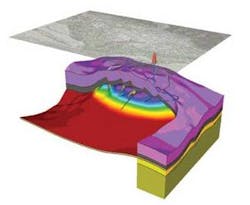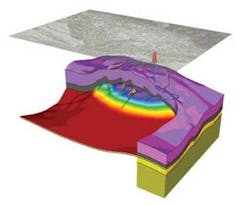RSS case study: Steerability in the GoM subsalt
Henry Mata, Michael McDonald, Ian Thomson - Baker Hughes
A Gulf of Mexico deepwater development well to be drilled from a fixed drilling facility expected to encounter approximately 5,000 ft (1,524 m) TVD of salt with potential inclusions at the base. Subsalt tar attack was a potential drilling hazard with pressure regression expected below the rubble zone prior to hitting the target sands.
The project objectives were to:
- Maintain verticality to the top of the salt and through the upper rubble zone
- Minimize vibration and optimize ROP in the salt
- Eliminate vibration-related tool failures
- Build and turn in the salt to ensure accurate wellbore placement.
Offset wells: predrill studies
Application engineers, working with the operator, determined the typical salt problems of downhole tool failures, unplanned events, significant nonproductive time (NPT), reduced ROP, and increased drilling costs were caused by:
- Lack of pilot bit and reamer synchronization, leading to the pilot bit outdrilling the reamer, especially when drilling through inclusions in the salt. This, in turn, caused lateral vibration and bit whirl
- Excessive vibration, the main reason for the tool failures, while drilling and underreaming, and performing directional work in the salt.
The Baker Hughes real-time optimization service acquired actual detailed downhole drilling parameters, monitored BHA drilling dynamics to diagnose the problems, and developed drilling optimization solutions.
Recommendations and solutions:
16 1/2-in. pilot bit x 19-in. expandable reamer section: Vertical hole entering the salt
In the upper ruble zone and top of the salt, high local stresses and dips can deflect the bit and BHA from vertical, creating high degree local doglegs and demanding corrective directional work. This can lead to increased casing wear and torque. Effective weight transfer to the bit was critical when drilling transition zones, such as salt entry. A slightly longer bit gauge and proprietary technology has been an effective approach.
The team recommended an optimized, stiff BHA with the Baker HughesAutoTrak rotary closed-loop system, real-time optimization service, and a fit-for-purpose HCD-507Z PDC bit with 6-in. longer-than-standard gauge length. The section was drilled and underreamed in one run. Vibration levels were minimized with excellent verticality while entering the top of the salt and to TD.
14 1/2 in. pilot bit x 16 1/2 in. expandable reamer section: Directional work through the salt
To achieve the upper and lower Miocene objectives, extensive directional work was planned in this section. It was crucial to have the pilot assembly well stabilized and to guarantee the proper reamer stabilization. Proper stabilization also preserved the mechanical integrity of the BHA by keeping the bending loads below the fatigue limit of each BHA component. Extensive BHA and bit selection optimization analysis eliminated vibration-related failures for optimum steerability in the salt. Strict attention was give to BHA stability and integrity with the pilot bit and reamer synchronized for aggressiveness.
In the upper BHA above the reamer, stabilization and drill collars size reduced or eliminated drill collar whip, common when underreaming. Larger, stiffer drill collars, which are less prone to vibration, added system stability, and helped prevent twistoffs. Throughout the system optimization process, proprietary modeling software optimized the BHA design.
A deep kickoff around 12,500 ft (3,820 m) MD or almost 2,000 ft (510 m) into the salt was performed flawlessly from vertical. Inclination was built from vertical at 1.8º to 2.2º/100 ft (30 m) dogleg severity to approximately 60º with AutoTrak technology and the designed-for-purpose HCD-507Z PDC bit. Verticality was maintained to the kick-off point to minimize potential collisions with existing wells. The BHA delivered optimum steerability in the salt body with minimum vibration and optimum ROP. This tangent section was drilled to exit the base of the salt at about 16,500 ft (5,029 m) MD and drilled to approximately 19,000 ft (5,791 m) MD.
The service company’s patented depth-of-cut control technology prevented the pilot bit from outdrilling the reamer to allow increased WOB, minimum torque fluctuation, and BHA stability without compromising ROP.
Conclusions
All of the operator’s objectives were met. A total system approach and continuous communication with the operator were crucial to vibration mitigation and increased overall drilling performance during the salt directional work. This enabled planning for the whole system rather than trying to optimize each component separately. The two sections were drilled with minimum vibration, zero tool failures, flawless deep kickoff into the salt while successfully exiting the salt, and drilling through the rubble zone with improved performance. The key for stability was to keep the pilot bit continuously loaded throughout the run. By limiting and engineering the cutter exposure at the cone and nose of the bit, more weight can be applied with less reactive torque to reduce the risk of the bit outdrilling the reamer, thereby contributing to stability.

